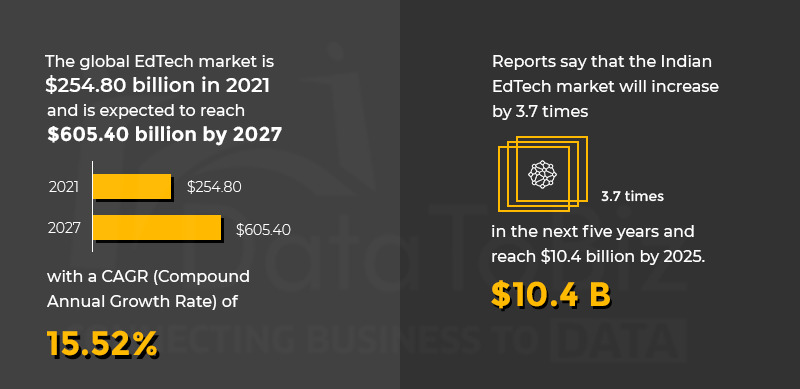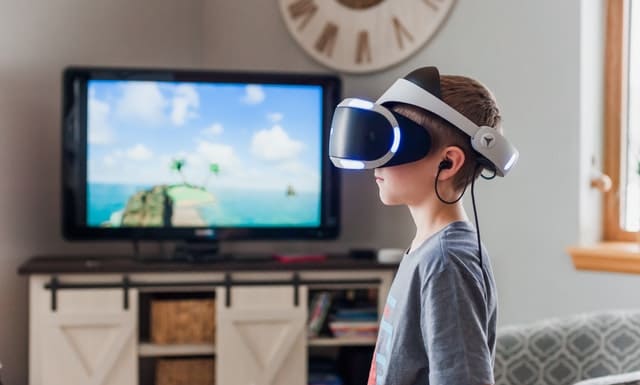The global EdTech industry is all set to grow leaps and bounds. With an increasing demand for inclusive and immerse learning, educational institutions have no choice but to adopt education technology. The future of EdTech shows great promise, though it is not without a few challenges to overcome.
EdTech is short for education technology, where IT tools are combined with educational practices to assist teachers to streamline the process and provide a holistic learning environment for students. While technology has been taught as per the syllabus, it is now an inherent part of the teaching and learning environment.
The pandemic has disrupted everyone’s lives and forced us to create new routines. Many industries suffered losses due to the lockdowns and restrictions. However, eCommerce and EdTech industries gained momentum and brought better changes into our lives. Online learning has been normalized. Using technology for learning and teaching is no longer something to frown at.
We have to admit that forced adoption hasn’t been smooth or stress-free. Teachers weren’t trained to deal with eLearning. Students didn’t have the necessary devices to access online classes. Things are still not 100% convenient and comfortable. Nevertheless, we are getting there at a steady pace. Thanks to their natural instincts, teachers were able to adapt to online teaching in their own ways. Students, especially from marginalized communities, are provided with the necessary devices and infrastructure to join the eLearning wagon.
The EdTech companies deserve a special mention for the tools, solutions, platforms, and services they provide to assist teachers, educational institutions, and students (parents) in seamlessly adopting education technology and positively dealing with the changes. The global EdTech market is $254.80 billion in 2021 and is expected to reach $605.40 billion by 2027 with a CAGR (Compound Annual Growth Rate) of 15.52%. Reports say that the Indian EdTech market will increase by 3.7 times in the next five years and reach $10.4 billion by 2025.

The future of EdTech looks bright and attractive, with great opportunities to provide inclusive learning and bridge the gap between people and education. However, this is possible when the learning strategies are aligned with the basic principles of the EdTech Readiness Framework (ERF). ERF mainly focuses on encouraging digital adoption at the family level, creating awareness about EdTech, investing in EdTech tools, and actively funding/ promoting EdTech companies to bring more innovations into the market.
What Does the Future of EdTech Look Like?
Education technology is not a stop-gap solution or a temporary arrangement until we go back to the previous ways of teaching. EdTech is mainstream and the future of education. It is a solution to provide a quality learning environment and empower teachers to reduce their non-teaching workload. We can see the following in the future of education technology in India and around the world.
Investments in EdTech
We have seen an increase in investments in EdTech in 2020, though the major focus has been on big names in the industry and already established companies. Venture capital investors find it difficult during the initial stages, mainly due to the lack of specialization and the access to the network that takes them closer to the consumer market.
EdTech companies focusing on specific domains are seeing the results of their efforts. They know their target market and have what it takes to attract high investments to better their products and services. In the future of EdTech, investors will continue to play a crucial role. It’s up to the EdTech companies to determine the way forward through specialization instead of the generalized approach.
Continuous Learning
The ultimate aim is to provide continuous learning facilities to students and prepare them to enter the global arena with confidence. Online learning is considered the route to continuous learning. Many universities offer online courses from students from other countries.
Various platforms like Coursera and Udemy provide a plethora of courses and diplomas for students to gain skills and knowledge. The latest Union Budget by the Indian government (for 2022-23) proposed digital university and TV-aided education to prevent ‘learning loss’ due to various reasons. The e-Vidya scheme initiated by the Prime Minister will take technology and education to remote parts of the country and encourage continuous learning.
Blended Teaching Programs
Blended learning combines physical and digital learning to provide a new-age learning system for students. Blended learning is also called hybrid learning or physical learning. It is a cost-effective choice for students as they can learn from their existing locations instead of spending money on travel, accommodation, etc.
Teachers can have a flexible schedule by dividing lessons between online and physical classes. The online classes can be recorded in advance and shared with the students. Study material can be provided online instead of asking students to buy or loan physical copies of textbooks.
Artificial intelligence-based tools like PrepAI assist teachers in automating their workload by generating question papers using technology. Teachers can use these question papers to conduct online and offline tests to evaluate students. Instead of spending hours preparing the question paper, teachers can automatically generate it in a few minutes.
Big Data and Data Analytics
Big data, data analytics, and artificial intelligence will have a crucial role in the future of EdTech. Various AI-based tools are available to assist teachers streamline their work and completing it in less time. By automating recurring activities like generating question papers and assessing the answer sheets, teachers can use their time effectively to provide high-quality education to the students.
Data analytics provides educational institutions and teachers with the necessary insights to help them understand students’ learning abilities. Analytics give insights about the subjects/ topics students find hard to learn. Teachers can know the weak areas of each student and create a teaching module that helps strengthen the weaknesses and encourage students to perform better.
Data Privacy and Cybercrime
With laptops and smartphones becoming a part of the classrooms, we need to pay extra attention to data privacy and ensure that students can deal with cyberbullying and attacks. By helping students understand the role of technology in education, we can create a holistic environment where they also learn how to recognize cybercrime in different forms and safeguard themselves from becoming victims.
Learning Experience Platform
We already know about LMS or the Learning Management System. The next stage of LMS is LEP, a Learning Experience Platform, a cloud service that delivers a personalized learning experience to students. It is one of the future trends in the EdTech industry and is considered a better option than LMS.
LEP aims to promote self-directed learning where teachers play the role of mentors and guide the students to learn at their convenience. LEP is a proactive approach to empowering students by creating unique learning experiences for each of them. For example, PrepAI is an AI-based platform that automatically generates question papers for the given input data. While this solution saves time for teachers, it is equally useful for students. Students can perform self-assessments by generating automated questions and answering them to test their knowledge.
Video-Based Learning (AR, VR, and ER)
Video-based learning doesn’t mean live streaming online classes or using platforms like Zoom, Google Meet, etc., to conduct classes. Here, video learning refers to advanced technology such as Virtual Reality, Augmented Reality, and Extended Reality.
The idea is to cost-effectively integrate these technologies into the classroom and online learning programs. eLearning has to be an immersive experience where teachers and students enter a new world to visualize the subject/ topic differently. While VR, AR, and ER are not yet mainstream in the Indian educational system, it won’t be long before schools and colleges adopt these technologies. We can already see platforms like Byjus using AR and VR to provide a 3D learning experience to students.
Gamification of Learning
AI-based games and simulations are being used to make learning fun and interesting. EdTech companies are actively providing teachers with gamification platforms and apps to convert the syllabus into innovative games and encourage students to compete and do better. Teachers will continue to monitor the progress and ensure that the competition between students is healthy and the learning environment is positive.
Consolidating LMS to Streamline Usage
Availability of technology and EdTech tools is just one part of the process. The success of education technology lies in how well educational institutions and teachers can streamline the use of these tools to eliminate barriers and create an interactive learning environment. Training teachers is the key to empowering them to use the latest technology with ease. When teachers can seamlessly navigate between systems, they will be less stressed about providing quality education to students.
At the same time, EdTech companies should work on third-party integrations between different platforms and tools to increase interoperability and assist teachers/ educational institutions in consolidating LMS.
Conclusion
EdTech companies will make inclusive learning possible through assistive technology. People with disabilities and marginalized communities will now have more opportunities to access education and finally have an equal footing with the rest of the world. One of the major future trends of EdTech is the technology that’ll eliminate the barriers between students with special needs and the educational system. It will also be interesting to follow the investments in the EdTech industry in the next few years.


